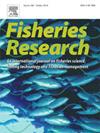Investigating the relative vulnerability of a temperate coastal fish community to a live wrasse pot fishery
IF 2.3
2区 农林科学
Q2 FISHERIES
引用次数: 0
Abstract
The European live wrasse fishery is a data limited fishery without a formal assessment. ICES recommends using the Productivity Susceptibility Analysis (PSA) to determine the relative vulnerabilities of species caught within data-limited fisheries. The PSA framework evaluates species’ relative vulnerability to overexploitation by scoring productivity and susceptibility attributes, from which relative vulnerability is calculated as a combination of these scores. The relative vulnerability of five target species and 55 potential bycatch species was investigated using the PSA framework, and findings were compared with published vulnerability estimates achieved by other methods. One target species, cuckoo wrasse Labrus mixtus, was of major concern, and another, ballan wrasse Labrus bergylta, was of moderate concern. Both are long-lived sequential hermaphrodites and should be prioritised for further quantitative assessment. Two bycatch species, viviparous eelpout Zoarces viviparus and spurdog Squalus acanthias, were of high concern. Both are viviparous fishes with low fecundity and long gestation periods. However, spurdog are distributed outside of the wrasse fishery and have never been reported as bycatch, so this species should not be considered vulnerable to this fishery. These results highlight the need to prioritize data collection for cuckoo and ballan wrasse and establish bycatch reporting for high-concern species. Vulnerability estimates were not consistent with those achieved by other methods, except for spurdog, which were of high concern due to their low productivity. However, discrepancies in the output of these methods are expected as the PSA framework incorporates fishery context, not just life-history traits.
调查温带沿海鱼类群落对活濑鱼锅渔业的相对脆弱性
欧洲活濑鱼渔业是一个数据有限的渔业,没有正式的评估。国际ICES建议使用生产力易感性分析(PSA)来确定在数据有限的渔业中捕获的物种的相对脆弱性。PSA框架通过对生产力和易感性属性进行评分来评估物种对过度开发的相对脆弱性,相对脆弱性由这些得分的组合计算。利用PSA框架对5种目标物种和55种潜在副渔获物种的相对脆弱性进行了调查,并将调查结果与已发表的其他方法得出的脆弱性估计数进行了比较。其中一个目标物种杜鹃濑(Labrus mixtus)是主要关注的,另一个目标物种巴兰濑(Labrus bergylta)是中等关注的。两者都是长寿命的顺序雌雄同体,应优先进行进一步的定量评估。两种副渔获物——胎生鳗鱼(Zoarces viviparus)和棘角狗(Squalus acanthias)受到高度关注。两者都是胎生鱼类,繁殖力低,妊娠期长。然而,棘鱼分布在濑鱼渔业之外,从未报道过作为副渔获物,因此该物种不应被视为易受这种渔业的影响。这些结果表明,需要优先收集布谷鸟和巴兰濑鱼的数据,并建立高度关注物种的副渔获报告。漏洞估计与其他方法取得的结果不一致,除了spurdog,由于其低生产率而引起高度关注。然而,由于PSA框架纳入了渔业背景,而不仅仅是生活史特征,预计这些方法的输出会出现差异。
本文章由计算机程序翻译,如有差异,请以英文原文为准。
求助全文
约1分钟内获得全文
求助全文
来源期刊

Fisheries Research
农林科学-渔业
CiteScore
4.50
自引率
16.70%
发文量
294
审稿时长
15 weeks
期刊介绍:
This journal provides an international forum for the publication of papers in the areas of fisheries science, fishing technology, fisheries management and relevant socio-economics. The scope covers fisheries in salt, brackish and freshwater systems, and all aspects of associated ecology, environmental aspects of fisheries, and economics. Both theoretical and practical papers are acceptable, including laboratory and field experimental studies relevant to fisheries. Papers on the conservation of exploitable living resources are welcome. Review and Viewpoint articles are also published. As the specified areas inevitably impinge on and interrelate with each other, the approach of the journal is multidisciplinary, and authors are encouraged to emphasise the relevance of their own work to that of other disciplines. The journal is intended for fisheries scientists, biological oceanographers, gear technologists, economists, managers, administrators, policy makers and legislators.
 求助内容:
求助内容: 应助结果提醒方式:
应助结果提醒方式:


